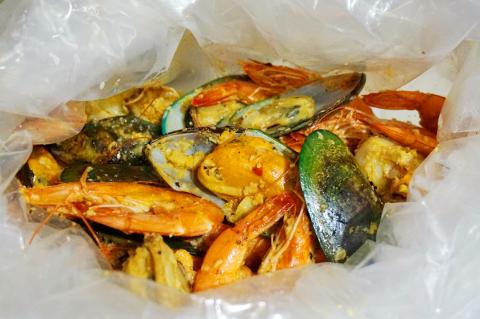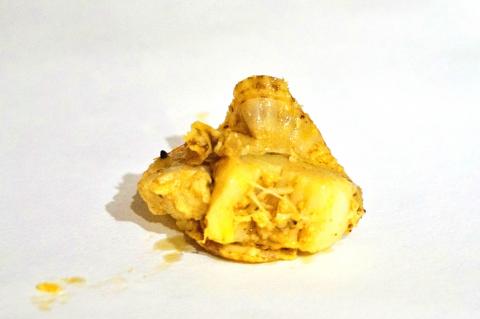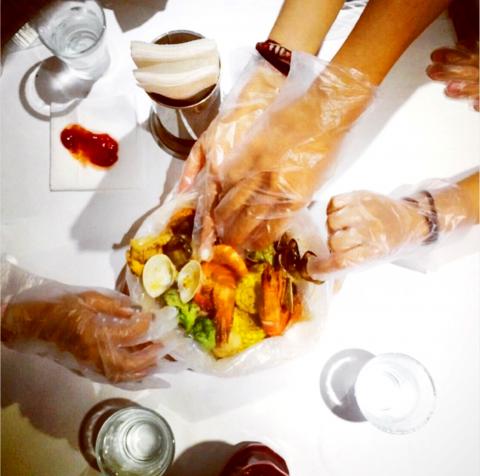Brookhurst Seafood Bar serves goodness in a bag. Literally. Customers sit down, fasten plastic bibs around their necks, slip on gloves and proceed to rip apart shrimp and lobster swimming in a herb and garlic sauce inside a plastic bag. The goodness doesn’t stop there. Scallops, shrimp and mussels are strewn all over the restaurant’s paper-covered tables. Diners pick and poke at them, chuckling, commiserating and taking selfies with their iPhones which are protected by complimentary zip lock bags.
The owner of the restaurant, Taiwanese-American Wendy Wu (吳欣穎), came up with the concept she calls “grub and chug,” on a trip to Los Angeles last year when she dined at The Boiling Crab, a joint serving seafood in a similar fashion. She wanted the food at Brookhurst to be served with less butter though, and thought it would be helpful to provide gloves and cellphone bags so that diners could still go through their usual routine of uploading food pictures to Facebook and Instagram.
“Today’s generation is phone savvy,” Wu tells the Taipei Times.

Photo: Dana Ter, Taipei Times
Spending the last decade shuttling back and forth between Taipei and Los Angeles, Wu’s career has spanned from being a radio DJ for ICRT to working retail for fashion brands and singing and performing on stage. Her entire right arm is inked (her husband is a tattoo artist/hipster-vintage store owner) and she has an infectious personality.
Once they had their concept, Wu and the restaurant’s other two partners, Lareine Ko (徐瑞蓮) and Johnny Fei (費聿鋒) spent two months perfecting their “secret sauce” in Wu’s kitchen. For months, her house reeked of herbs, garlic and butter.
“I would wake up in the morning sweating the sauce,” Wu says.

Photo: Dana Ter, Taipei Times
Their efforts paid off because the restaurant, which opened in February, was packed on a Tuesday night when a friend and I dined there. The most popular pick is, of course, the seafood bag, otherwise known as their “BS Combo” where customers choose from an assortment of clams, mussels, white shrimp and Hokkaido scallops. Sauce-wise, the lemon zing is recommended for those with lighter palates, while the Brookhurst bang and Cajun sauces are better suited for those who can take the garlic. The spiciness of the sauce can also be adjusted. The smallest combo, the shrimp and shells (NT$999) feeds two people, while the largest combo, the big catch (NT$5,990), which comes with king crab legs, Boston lobster and a selection of shrimp, is suitable for large groups. There is a generous selection of add-ons on the menu, including veggies and meat. The German and smoked sausages (NT$80), which I had, is a fine choice. However, the meal isn’t complete without something to slop up the sauce with. For that, I ordered slices of French baguette (NT$30).
While many restaurants are judged by their presentation — after all, it’s an important element in the overall dining experience — presentation is least paramount at Brookhurst. Being able to dig into your food with your hands and laying it out on the table without plates has its benefits. For starters, it’s easier to see and feel what you’re eating. Not only that, the entire concept of “grub and chug” taps into our innate childlike propensity to have fun and create a mess.
The mussels, Hokkaido scallops and white shrimp complemented each other well. The mussels were cooked in such a way that they were soft, warm and chewy without a discernible tinge of the rubbery. Lightly seared on the outside, the Hokkaido scallops were warm and mildly cod-like on the inside. By contrast, the white shrimp had a robust natural sweetness and subtle buttery texture which paired well with the more neutral flavors of the mussels and scallops. The German and smoked sausages were a fine addition to the seafood bag, adding a juicy, tender dimension.

Photo: Dana Ter, Taipei Times
What pulls it all together, however, is the sauce. Neither too thick nor too watery, the Brookhurst bang was a delightful blend of spices, herbs, garlic and butter. There were hints of paprika, pepper and ginger, making it bold and flavorful. I chose my sauce to be mildly spicy, and that gave it just enough zing without having to compete with the freshness of the seafood. The best way for savoring the sauce was dipping my baguette in it and wiping it clean.
Although Brookhurst might be a no frills seafood bar, it is up there when it comes to thrills. Along with clam shells, proper restaurant etiquette is thrown out the window as hungry diners pick their way through seafood bags. While not exactly the best date night spot, in theory, Brookhurst provides a well-suited venue for catching up with friends and being sloppy without being judged.
“I know it’s cliched to say that food brings people together, but it does,” Wu says.

Photo courtesy of Brookhurst Seafood Bar
She adds that she hopes that the restaurant can help bring friends who have drifted apart — because of marriage, babies or whatever reason — back together, bringing a human touch back to the dining experience.
Sure, I thought as I caught a side-glimpse of the two immaculate girls next to me pausing to take selfies with crab claws every 10 seconds.

Photo courtesy of Brookhurst Seafood Bar

Exceptions to the rule are sometimes revealing. For a brief few years, there was an emerging ideological split between the Democratic Progressive Party (DPP) and Chinese Nationalist Party (KMT) that appeared to be pushing the DPP in a direction that would be considered more liberal, and the KMT more conservative. In the previous column, “The KMT-DPP’s bureaucrat-led developmental state” (Dec. 11, page 12), we examined how Taiwan’s democratic system developed, and how both the two main parties largely accepted a similar consensus on how Taiwan should be run domestically and did not split along the left-right lines more familiar in

As I finally slid into the warm embrace of the hot, clifftop pool, it was a serene moment of reflection. The sound of the river reflected off the cave walls, the white of our camping lights reflected off the dark, shimmering surface of the water, and I reflected on how fortunate I was to be here. After all, the beautiful walk through narrow canyons that had brought us here had been inaccessible for five years — and will be again soon. The day had started at the Huisun Forest Area (惠蓀林場), at the end of Nantou County Route 80, north and east

Specialty sandwiches loaded with the contents of an entire charcuterie board, overflowing with sauces, creams and all manner of creative add-ons, is perhaps one of the biggest global food trends of this year. From London to New York, lines form down the block for mortadella, burrata, pistachio and more stuffed between slices of fresh sourdough, rye or focaccia. To try the trend in Taipei, Munchies Mafia is for sure the spot — could this be the best sandwich in town? Carlos from Spain and Sergio from Mexico opened this spot just seven months ago. The two met working in the

This month the government ordered a one-year block of Xiaohongshu (小紅書) or Rednote, a Chinese social media platform with more than 3 million users in Taiwan. The government pointed to widespread fraud activity on the platform, along with cybersecurity failures. Officials said that they had reached out to the company and asked it to change. However, they received no response. The pro-China parties, the Chinese Nationalist Party (KMT) and Taiwan People’s Party (TPP), immediately swung into action, denouncing the ban as an attack on free speech. This “free speech” claim was then echoed by the People’s Republic of China (PRC),